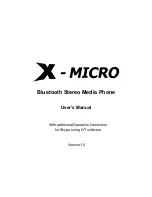
SP-1
•
19
Procedure to hook-up external battery:
1. Remove (or don't install) zener diode D5.
2. Change R10 from 100 to 270 ohms (red-violet-brown).
3. Install the 9V battery snap connector near S1. Red is positive, black is
negative or ground.
4. Connect "X" near S1 to "X" near D5, using hookup wire.
5. Install a fresh 9 volt battery. It will be in use only when S1 is "off the
hook."
SP1 CIRCUIT NOTES:
Schematic diagram also provides a sufficiently complete block diagram of the
MC65118's functions. How self- evident the circuit functions seem to you
depends on your level of electronics experimenting or learning. Here are the
highlights of what makes the SP1 tick.
S1: A and a jumper from B to A connect the circuit to the phone line's two wires.
There's nothing hi-tech about calling these two wires "tip" and "ring." That's our
inheritance from manual switchboard days. Tip and ring referred to parts of the
plug and patch cord sets handled by the operator. As mentioned, S1: A
performs the same function as a conventional telephone "hook" switch. As soon
as S1 is pressed in, the central office equipment is able to sense that the SP1
is connected to the line or "loop."
The phone line carries both audio energy (AC) and DC voltage. T1 and T2
couple the audio signals to U1's hybrid amplifiers (pins 5 and 6). In telephone
terminology, "hybrid" is a circuit that divides a single transmission channel into
two, one for each direction. Diodes D1-D4 are arranged to make the input
insensitive to DC polarity: the circuit gets correct DC polarity no matter which
way the phone line is connected!
U2 is a self-contained audio amplifier capable of outputs up to 400 miliwatts,
quite sufficient to drive quality speakers to room volume. This same LM386 is
also used in our receiver kits with great results.
Switch S2 simply activates the microphone amplifier muting feature built into
the speakerphone IC. Pin 12 is ordinarily low (0 voltage) for normal operation.
The microphone input circuitry is set up to accommodate both self-powered
microphones and those which require a small DC voltage for proper operation.
Hands-free intercom operation is the same as half-duplex speakerphone
operation except that a source of DC voltage is required. This is made easy by
S1B and a jumper from A to C.
Perhaps the easiest overview of the circuit would be the following pin by pin
notes on the MC65118. In these notes and on the schematic, BNM+
"background noise monitor." TX = transmit. RX = receive.






































